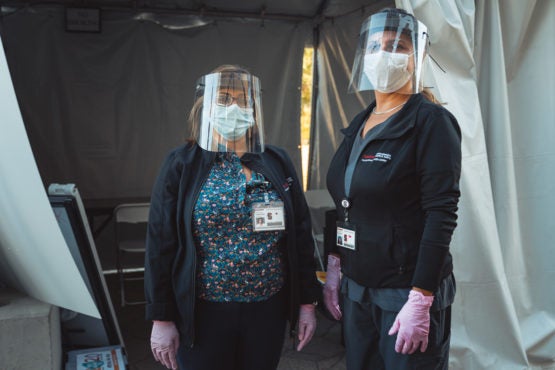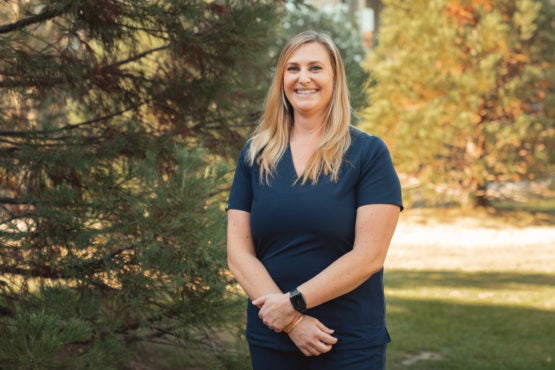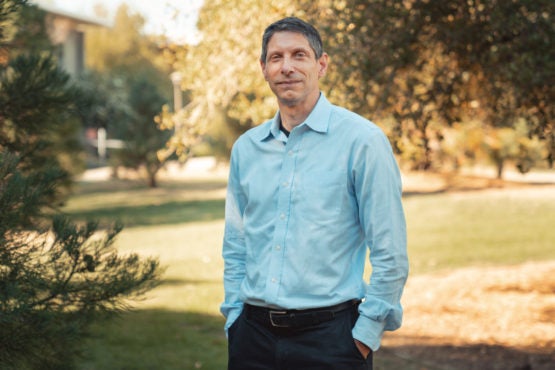Stanford’s COVID-19 surveillance testing a crucial tool for return to campus
Initial results in Stanford’s surveillance testing program, which began with autumn quarter, show a low prevalence of COVID-19 and serve as a reminder to maintain health protocols for those who are working and studying on campus.
A typical autumn on the Farm finds a bevy of activity in the conference spaces of the Arrillaga Alumni Center. But in the pandemic, most visitors to the center’s McCaw Hall instead are students taking COVID tests.

Dr. Minal Moharir and medical assistant Maria Martinez work at the Occupational Health Center COVID-19 testing tent at the Environmental Health & Safety building. (Image credit: Andrew Brodhead)
The autumn quarter testing program for students began Aug. 31 and was phased in during September for faculty, staff and postdoctoral scholars who are regularly on the main campus or Stanford Redwood City.
After nearly two months of testing, the results have been encouraging.
As of Nov. 2 Stanford’s COVID dashboards show the surveillance testing program had 22 positive tests by students out of more than 43,000 tests. More than 11,000 Stanford-facilitated surveillance tests for faculty, staff and postdoctoral scholars found one positive test result.
“The results thus far demonstrate a remarkably low prevalence of COVID-19 among students living on campus and coming onto campus and effectiveness of the public health measures put into place by the university and the county,” said James R. Jacobs, a medical doctor who is associate vice provost for student affairs and executive director of Vaden Health Services.
The testing program, which is aimed at people who are not experiencing COVID-19 symptoms, is a crucial component of the university’s approach to keeping the campus community as healthy as possible and fostering research and education.
The university also learns from other sources of positive tests. In addition to the bar graphs and reported positivity rate, which only reflect testing of asymptomatic people at Stanford, the dashboards also include “total confirmed positive cases.” These cumulative totals, which date to March 2020, include test results from any provider, not just the Stanford program. Sources include self-reporting into Health Check, hospital notification or other reporting means, and are verified by a university clinician.
“Student participation in the testing protocol has been good overall but uneven some weeks,” Jacobs said. “We’re now sending friendly reminders to individual students not meeting the requirement, and we hope it will improve compliance. If not, we may need to consider other approaches, especially if we’re able to have more students on campus in the winter.”
On the employee front, participation is rising week over week, said Rich Wittman, medical director at the Occupational Health Center, which provides on-campus medical services to employees. He said he is working with colleagues to continue that trend as the winter flu season approaches.
Confirming and support protocols
“Stanford’s approach is threefold,” Wittman said. “We utilize Health Check and other measures to prevent those who might be infected from coming to campus, respond quickly to minimize secondary transmission from those who may already be on campus, and promote the positive impact of masking, social distancing and regular testing.”
Voluntary, self-administered testing on a weekly basis is recommended for faculty, staff and postdoctoral scholars who make at least one campus visit per week. These include workers providing essential on-campus services, individuals involved in research, and other faculty, staff and postdoctoral scholars who have been approved to work on campus and who report their health status using Health Check.
Space has been set aside in other buildings and in tents outside Environmental Health & Safety for collecting employee test kits.
To minimize crowding at McCaw, student testing is by appointment only. Students line up outside the building, enter from the Galvez Street entrance instead of the alumni lobby, and follow protocols including masks and physical distancing.
Inside, the tests are self-administered by students, as well as postdocs living in Stanford housing assigned by Residential & Dining Enterprises. Testing stations are spaced far apart and contact with the health care workers who observe them is limited. Each test takes about five minutes, but 15-minute slots are set aside to provide sufficient time for sanitization between students. Ventilation is designed to bring in fresh air from outside and push it out, rather than recycle it.
Expanding options for testing
Over the summer a task force, convened by Provost Persis Drell and chaired by Lloyd Minor, dean of the School of Medicine, recommended surveillance testing. Testing had been available on campus since May, but needed to be expanded because of the volume of testing required and ongoing supply chain challenges that have resulted from the pandemic.
Stanford contracted with two testing firms with different supply chains and whose methodologies have FDA emergency use authorization. Verily, a company focused on life sciences research and health care, oversees collection of samples and processing for students. Color, which specializes in population health management, provides the nasal-swab testing kits for self-collection by employees and performs clinical lab testing on the kits they submit.
All student testing is conducted at McCaw. Employee test kits can be picked up and dropped off at seven locations, including SLAC, Stanford Redwood City and Hopkins Marine Station in Pacific Grove. Individuals who need assistance with the technology or have language barriers can get help with testing in tents in front of the Environmental Health & Safety building.
Testing is free, regardless of a student’s or employee’s health plan.
Building a flu shot experience
Although the scale and urgency are unprecedented, experiences from the earlier testing and the annual flu shot program have been instructive, said Erin Davis, a nurse practitioner and Occupational Health Center clinical operations manager who helps oversee the testing sites.

Nurse practitioner Erin Davis is manager of clinical operations who oversees campus COVID-19 testing sites. (Image credit: Andrew Brodhead)
“The closest experience is the big flu clinics we do every year, because the logistics are similar – staffing and supplies and scheduling,” Davis said. “Also, we had quite a few people take tests this summer, so we already had a bit of a workflow and kind of knew what it was going to take.”
Davis said those experiences have helped her and her colleagues adjust to the additional demands. About 10 additional clinical support staff have been added. Volunteers at the added locations have done everything from helping secure storage space to setting up signs and taping 6-foot markers on floors. Instructional guides are available in English, Spanish, Mandarin, Portuguese, Tagalog and Russian.
Students testing positive are referred to Vaden Health Services for treatment and care. Employees will be asked to self-isolate.
Health officials and administrators caution that those being tested must remain vigilant – and continue to practice physical and social distancing, the proper use of double-layered face coverings with no valves, hand hygiene practices and daily Health Check submissions.
Those involved in the testing program say the steps being taken and information gleaned from tests help protect students and employees and inform the university’s decisions.
“It’s a testament to Stanford’s commitment to keep our campus population safe and healthy,” Davis said.
Details about COVID-19 surveillance testing program for autumn quarter are available here.

